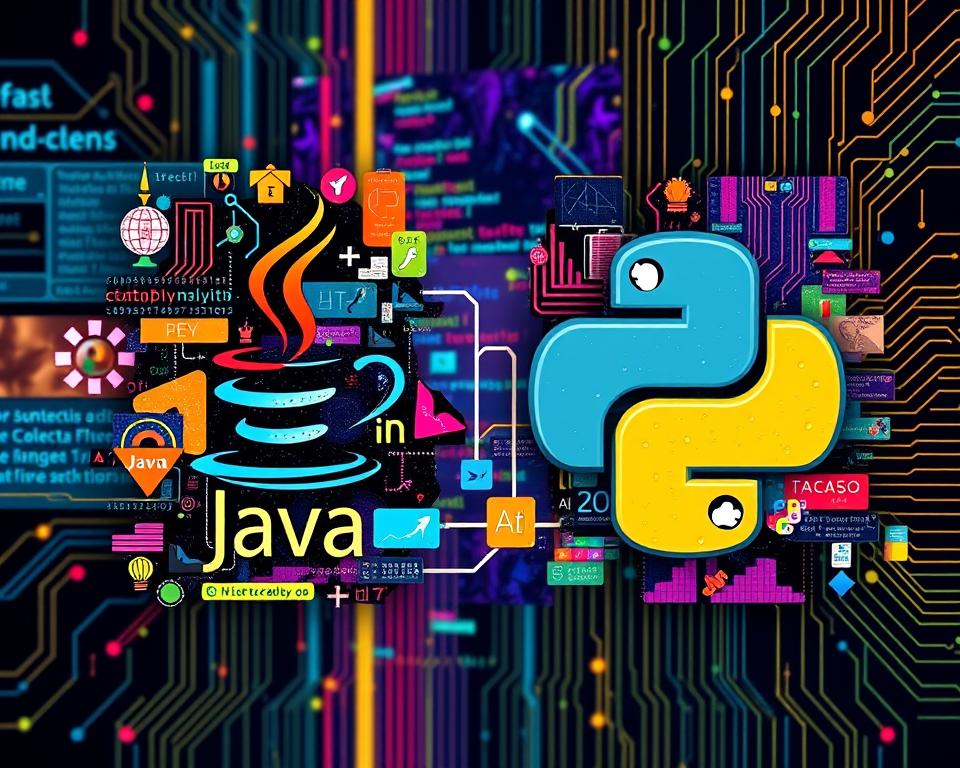Technology keeps getting better, and the need for programmers is growing. Java and Python are two languages getting a lot of attention. It’s hard to pick the right one for your project because each has its own strengths.
In this article, we’ll look at the main differences and similarities between Java and Python. This will help you decide which language fits your needs best.
Table of Contents
Key Takeaways
- Java and Python are both widely used programming languages with distinct features and applications.
- Understanding the fundamental concepts, programming paradigms, and development tools is crucial when selecting a language.
- Factors such as syntax, code readability, performance, learning curve, and community support should be considered when choosing between Java and Python.
- The choice between Java and Python often depends on the specific project requirements, development team expertise, and future growth opportunities.
- Both languages offer a wide range of career opportunities, with Java being more dominant in enterprise-level applications and Python excelling in data science and web development.
Understanding Programming Language Fundamentals
To become a skilled programmer, it’s crucial to know the basics of programming languages. These programming basics and coding fundamentals are the foundation for making efficient software. They help in creating effective applications.
Basic Programming Concepts
Programming starts with key concepts like data types, variables, control structures, and algorithms. Learning these basics is vital for any programmer. They help in writing clean, readable, and maintainable code.
Importance of Language Selection
The choice of programming language greatly affects development and the final product. Consider project needs, team expertise, performance, and target platform when picking a language.
Programming Paradigms Overview
Programming languages fall into different programming paradigms, like object-oriented, functional, and procedural. Knowing these paradigms helps developers choose the best approach for their project. It leads to more efficient and effective code.
“The choice of programming language is a key decision that can have a profound impact on the success of a software project.”
Understanding these fundamentals is key for aspiring programmers. It builds a strong foundation for coding. This enables them to make informed decisions and create high-quality software applications.
Java vs. Python: Key Differences and Similarities
Java and Python are two top programming languages. They share some basics but also have unique features. This section will explore their differences and similarities to help you choose the best language for your needs.
Language Syntax and Structure
Java and Python differ in their syntax and structure. Java has a verbose syntax. It requires developers to specify data types and use curly braces for code blocks. Python, however, is known for its concise and readable syntax, using whitespace and indentation.
Performance and Efficiency
Java is generally faster and more efficient than Python. It’s great for high-performance tasks like enterprise applications. Python, on the other hand, is simpler and easier to use. It’s often chosen for data analysis, machine learning, and quick prototyping.
| Feature | Java | Python |
|---|---|---|
| Syntax | Verbose, with strict type declarations and curly braces | Concise, with whitespace and indentation to structure code |
| Performance | Faster and more efficient for enterprise-level applications and high-performance computing | Simpler and more user-friendly, better suited for data analysis, machine learning, and rapid prototyping |
| Learning Curve | Steeper learning curve, more rigid and complex | Easier to learn, more accessible for beginners |
| Ecosystem and Community | Robust ecosystem with extensive libraries and tools, but smaller community compared to Python | Vast and vibrant community, with a wide range of libraries and tools available |
Java and Python have their own strengths and are suited for different projects. The choice between them depends on your project’s needs, your preferences, and your team’s skills.
“The choice between Java and Python is not a simple one; it depends on the specific needs of your project and your team’s preferences. Both languages have their unique strengths and are well-suited for different types of applications.”
Syntax and Code Readability Comparison
Programming languages have different syntax and code readability. Java and Python are two popular languages with unique approaches.
Code Structure Differences
Java’s syntax is seen as more detailed and structured. It has strict rules for formatting and organization. Python, however, focuses on simplicity and readability. It uses whitespace indentation instead of curly braces.
Formatting Requirements
Java has strict formatting rules, including specific naming and indentation guidelines. Python, on the other hand, has more flexible rules. This makes Python code more readable and concise.
Writing Clean Code
Both Java and Python value clean code practices. But they implement these differently. Java follows camelCase naming and the ‘one class per file’ rule. Python uses underscores for naming and promotes a Pythonic style for clarity.
| Feature | Java | Python |
|---|---|---|
| Code Structure | Verbose, structured, with strict formatting rules | Concise, relying on whitespace indentation for code blocks |
| Formatting Requirements | Rigid guidelines for naming, indentation, and use of semicolons | Flexible formatting, promoting readability and conciseness |
| Clean Code Practices | CamelCase naming, one class per file, following strict guidelines | Underscores for variable naming, Pythonic style for readability |
Understanding the syntax and code readability differences between Java and Python helps developers choose the best language for their projects. It depends on the project’s needs and personal preferences.
Performance and Speed Benchmarks
Programming languages are judged by how fast and efficient they are. Java and Python are two top choices, each with its own strengths and weaknesses. Let’s look at how they compare in terms of speed and performance.
Execution Time Comparison
Java is often faster than Python. Its compilation and just-in-time (JIT) optimization make it quicker, especially for tasks that need lots of CPU power. Studies show Java can be up to 10 times faster than Python in some cases.
Memory Usage and Efficiency
Python, however, uses less memory. Its dynamic typing and high-level design mean it’s more memory-friendly. This is great for systems with limited memory or big data sets.
| Metric | Java | Python |
|---|---|---|
| Execution Time | Faster | Slower |
| Memory Usage | Higher | Lower |
| Overall Efficiency | Highly Efficient | Moderately Efficient |
The speed and performance gap between Java and Python can change based on the task, code complexity, and system setup. It’s key to benchmark and profile carefully to pick the right language for your project.
In short, Java is better for fast execution and efficiency, especially for tasks that need lots of CPU power. Python is more memory-efficient and good for systems with limited memory. Choose Java or Python based on your project’s needs and constraints.
Learning Curve and Beginner-Friendliness
Choosing between Java and Python can greatly affect how easy it is to start learning programming. Both languages have their own benefits for new programmers. However, they differ in how easy they are to learn and how quickly you can get good at them.
Initial Learning Requirements
Java is seen as a more challenging language. It requires a deep understanding of programming basics, like object-oriented programming (OOP). Beginners might find Java’s syntax and structure hard because it needs more setup code and is more detailed.
Python, on the other hand, is known for being easy to start with. Its simple syntax and focus on being easy to read make it great for beginners.
Resources for Beginners
Both Java and Python have lots of resources for new learners. You can find online tutorials, coding bootcamps, and interactive platforms. There are free courses and detailed books to help you learn.
- Codecademy: Offers interactive, beginner-friendly courses in both Java and Python.
- Udemy: Provides a wide range of affordable online courses for learning programming, including Java and Python.
- Coursera: Features university-level courses and specializations in Java and Python, suitable for beginners.
Time to Proficiency
How long it takes to get good at Java or Python varies. It depends on your experience, how you learn, and how much you practice. Python is often quicker to learn, especially for beginners. Java might take longer because of its complex syntax and need to understand OOP.
In the end, whether to start with Java or Python depends on your learning style, goals, and the projects you want to do. Both languages have their own strengths and can be useful skills for programmers.
Career Opportunities and Job Market Demand
The tech industry is booming, and the need for skilled programming jobs is at an all-time high. Java and Python are leading the way in software developer salaries and tech careers. They offer many job opportunities for those looking to start their careers.
Recent reports show Python developers are in high demand, with a 22% growth in jobs from 2021 to 2031. Python is popular in data analysis, machine learning, and web development. Java, on the other hand, is a top choice for enterprise software, with strong demand in finance, healthcare, and e-commerce.
| Programming Language | Average Salary (US) | Job Market Outlook |
|---|---|---|
| Java | $105,590 | Steady growth, especially in enterprise software |
| Python | $120,730 | Rapid growth, particularly in data-driven industries |
Choosing between Java and Python depends on your career goals and the industry you want to work in. Both languages have plenty of programming jobs and opportunities for growth. They are great choices for anyone looking to start a career in tech careers.
“The future of software development lies in the hands of those who can master both Java and Python, as the demand for versatile and adaptable engineers continues to rise.”
Development Tools and IDEs Available
Programming languages like Java and Python have many development tools and Integrated Development Environments (IDEs). These tools greatly affect how you code and work. Developers can pick from a wide range of IDEs and tools that fit their needs and likes.
Popular Development Environments
Java developers often use Eclipse, IntelliJ IDEA, and NetBeans. These IDEs have strong features and lots of customization options. They help with editing, debugging, and testing code, making development smoother.
Python developers prefer PyCharm, Visual Studio Code, and Spyder. These tools are great for debugging, testing, and working with Python libraries and frameworks.
Debugging Tools
Debugging is key for any programming language. Java and Python have top-notch debugging tools in their IDEs. These tools let developers step through code, set breakpoints, and check variables, helping find and fix problems quickly.
Code Testing Features
Good code testing is vital for software quality and reliability. Java and Python IDEs work well with testing frameworks like JUnit for Java and unittest for Python. This lets developers write, run, and manage tests right in their development environment.
With many IDEs and tools for Java and Python, programmers can pick what works best for them. This improves their productivity and coding experience.
Community Support and Documentation
Choosing a programming language? The strength of the developer community and documentation quality are key. Python and Java, two top languages, have strong developer communities that offer great support and resources.
The programming forums for these languages are always buzzing. Here, developers can get answers, work on projects, and share tips. These online spaces are growing, filled with helpful info for all skill levels.
Both Java and Python have excellent documentation quality. Their official guides are detailed, well-organized, and simple to use. This makes learning their features easy. Plus, community contributions add to the wealth of resources and tutorials available.
The strong communities and top-notch documentation for Java and Python greatly help programmers. Whether you’re new or experienced, these ecosystems offer the support and resources you need to thrive in programming.
“The strength of a programming language’s community can make all the difference in your development journey.”
Enterprise Applications and Use Cases
In the world of enterprise software, Java and Python have found their places. They meet the needs of businesses in many fields. These languages help companies work better and stay competitive.
Industry Applications
Java is key in finance, healthcare, and e-commerce. It’s used for secure banking apps and complex hospital systems. Python, meanwhile, is great for data work in analytics, logistics, and science.
Popular Frameworks
- Java is often paired with Spring, a framework for big apps. Spring makes building and maintaining Java apps easier.
- Python users love Django for web projects. It’s fast, secure, and flexible, making it a top pick for web apps.
Real-world Examples
Java and Python are big in enterprise software. JP Morgan Chase uses Java for online banking. Spotify relies on Python for its music recommendations.
These examples show Java and Python’s value. They help companies create apps that boost innovation and efficiency.
Cross-platform Compatibility
Java and Python have different ways to handle platform independence and cross-platform development. Java’s “Write Once, Run Anywhere” (WORA) principle lets developers write code that works on many operating systems. This is thanks to the Java Virtual Machine (JVM), which acts as a bridge between the code and the platform.
Python is known for being easy to use on many operating systems. You can write and run Python code on Windows, macOS, and Linux without big changes. This is because Python code is interpreted by the Python interpreter, making it flexible.
Both Java and Python are great for developers who want their apps to work on different platforms. This portability is key in today’s world, where users want the same experience everywhere.
“The ability to write code once and deploy it across multiple platforms is a significant advantage that both Java and Python offer.”
Choosing Java or Python means your app will work on many platforms. This makes it easier to reach more people and saves time in development.
Security Features and Vulnerabilities
The digital world makes cybersecurity and secure coding more important than ever. Java and Python are key programming languages. Knowing their security strengths and weaknesses is vital for developers and businesses.
Security Best Practices
Java and Python have built-in security tools to help developers write secure code. But, the main job of keeping an app safe falls on the programmer. Following best practices like checking inputs, handling errors well, and using secure libraries is key. This ensures the data protection and vulnerability management of software.
Common Security Issues
- Java faces threats like buffer overflows, unintended code runs, and insecure deserialization. These can cause cybersecurity breaches if not fixed.
- Python is generally safer than Java but still faces risks like SQL injection, cross-site scripting (XSS), and bad input handling. These can harm data protection and security in an app.
Protection Mechanisms
Java and Python have security tools and libraries to tackle these common problems. For example, Java has the Java Cryptography Architecture (JCA) and Java Secure Socket Extension (JSSE) for safe communication and encryption. Python has the `urllib` and `ssl` modules for network security and the `hashlib` module for hashing and cryptography.
| Security Feature | Java | Python |
|---|---|---|
| Secure Coding Practices | Input Validation, Error Handling, Secure Libraries | Input Validation, Error Handling, Secure Libraries |
| Cryptography and Encryption | Java Cryptography Architecture (JCA), Java Secure Socket Extension (JSSE) | urllib, ssl, hashlib |
| Common Security Issues | Buffer Overflows, Unintended Code Execution, Insecure Deserialization | SQL Injection, Cross-Site Scripting (XSS), Improper Input Handling |
Knowing Java and Python’s security features and vulnerabilities helps developers make better choices. They can build secure applications that protect against cybersecurity threats and ensure strong data protection.
Future Prospects and Development
Programming languages like Java and Python are set to shape the coding future. Java is known for its strong typing and use in big companies. Python, on the other hand, is gaining popularity for its simplicity and flexibility.
Artificial intelligence (AI) and machine learning (ML) are changing the game. Python is a top pick for AI and ML because of its easy-to-read code and data skills. Java is catching up by adding AI and ML tools like TensorFlow and Deeplearning4j.
The Internet of Things (IoT) is another big area. Java is great for IoT devices because of its strong security. Python is easy to use and has lots of libraries, making it perfect for quick IoT projects.
| Metric | Java | Python |
|---|---|---|
| AI/ML Adoption | Adapting with frameworks like TensorFlow and Deeplearning4j | Preferred language for AI and ML development |
| IoT Applications | Ideal for embedded systems and IoT devices | Popular for rapid prototyping and IoT app development |
| Future Outlook | Remains a dominant player in enterprise and backend development | Continues to grow in popularity for data science, web development, and emerging technologies |
Java and Python will keep leading the programming world. Java will stay strong in big companies and critical projects. Python will grow in data science, web development, and new tech areas.
Conclusion
Choosing between Java and Python for programming is not easy. Both languages have their own strengths and fit different needs. Your decision should depend on your project, what you like, and your career goals.
Java is great for big, important projects because it’s strong and safe. It has a big community and lots of tools. Python is better for quick projects like data analysis and machine learning because it’s easy to use and flexible.
It’s important to keep learning and be open to new things in your career. Knowing how to use many programming languages can help you in your Java vs Python decision. It can also open up more career opportunities.
“The best programming language is the one that gets the job done.” – Anonymous
Knowing what Java and Python are good for can help you choose the right one for your project. But remember, the real success in software development comes from being able to adapt, learn, and grow as a developer.
| Consideration | Java | Python |
|---|---|---|
| Syntax and Readability | More verbose and strict | Concise and readable |
| Learning Curve | Steeper for beginners | Easier for beginners |
| Performance and Speed | Faster for certain tasks | Slower for certain tasks |
| Enterprise Applications | Stronger support and adoption | Gaining popularity in enterprise environments |
Choosing between Java and Python is not simple. It needs careful thought about your needs, goals, and each language’s features. By considering these points, you can make a choice that leads to a rewarding software development career.
Additional Resources and Further Learning
Looking to dive deeper into Java and Python? There’s a lot to explore online. You can find everything from detailed tutorials to interactive coding bootcamps. These resources can help you improve your skills in these languages.
Check out online courses on sites like Udemy, Coursera, and edX. They have something for everyone, from beginners to experienced developers. These courses offer structured learning and hands-on exercises to help you grow.
If you want a more hands-on experience, try a coding bootcamp. These programs are intense and focus on practical skills. You’ll get real-world experience and mentorship from professionals, helping you succeed in your chosen language.



















